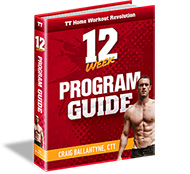Exercise Selection For The Beginner and Advance Athletes
 Say you have been training for awhile and fat loss is no longer your goal your. But you need a new style of training. I suggest you jump a back to part 4, to see why Alwyn nicknamed these types of people “the executive athlete”
Say you have been training for awhile and fat loss is no longer your goal your. But you need a new style of training. I suggest you jump a back to part 4, to see why Alwyn nicknamed these types of people “the executive athlete”
We are going to jump right into today’s interview series with the Results Fitness owner, Alwyn Cosgrove. If you would like to listen to the call click here.
****************
Craig: What about for a beginner? Someone that comes and signs up to the gym is obviously not getting put into the three ten minute sessions.
Do you have them stay out of classes for a while, or do you modify the classes for them?
Alwyn: The nice thing with this is that I can give them a very simple exercise, and their heart rate will tell me what’s going on. If I have complete beginner, I can tell them, “We’re going to work for a 20 second period and then rest until your heart rate comes down.”
I could have a beginner client doing a body weight squat, and I could have an advanced client doing a jump squat with dumbbells. The advanced client might do 60 seconds straight work, rest for 30 and do multiple sets. The beginner might do 15 seconds of work and rest for three minutes. They can go in with the disclaimer that, before we do any type of metabolic loading like that, we have to establish clean moving patterns.
With a beginner, I’ll bring them in and they’ll usually just do a strength training component for the first four weeks. I’ll get as much results out of basic strength training with a decent rest period, just teaching technique as we will out of anything else. It’s a change psychology. John Berardi has talked a wee bit about it. The least amount of change at any one time gives the biggest client endurance and success rate.
In the beginning, if they join the gym, I will do two strength training sessions a week with them, and that’s it. I don’t need to do anything else until I’ve plateaued with that. They will do a very basic program. Don’t confuse basic with slow results; basic gets great results. We start with a basic full body program.
I prefer to do more exercises for a lower volume with beginners than multiple sets. I might do one squat, one lunge, and so on. We might do eight to ten exercises in the session, then do three exercises for four sets each.
Craig: That’s fantastic, and it makes total sense. Going to some more advanced stuff, let’s talk about some of the cool stuff you have in your gym. I know you have one of those giant TRX things, and I know that there’s a bunch of TRXs. What’s the ultimate TRX set up for someone’s facility if they don’t have anything in their way?
Alwyn: I like the standard TRX, the TRX Suspension Training Pack. I like professional edition. It’s a little sturdier than the home edition, and the handles are rubber, whereas the home handles are foamy. For sanitary reasons, I like that one. I also like the one called the TRX Rip Trainer. It’s a horizontal cable device. Those are the two products I would use.
If you had the space I would get one for every three clients that’s coming in. If you are doing classes of 15, I would like five TRXs. If you are doing small group training, you just need one.
I’m involved with TRX on a level, but I just use the term “suspension training.” Those guys singlehandedly eliminated the stability ball from most gyms because there’s nothing that you can’t do better on a TRX than you were doing on a stability ball. It’s so versatile and it’s alive. Every rep is a slight adjustment and tweak. It becomes asymmetrical in nature with the loading. It’s the future of strength training.
If I give you a set of dumbbell presses, Craig, with 50 pounds, there’s a fatigue. Maybe you do nine or ten, and you can’t do any more. I can do a TRX chest press or TRX push up, which is a similar exercise. It’s the same muscles. I get more muscles involved because of the selection, but I when I hit fatigue I can move my feet, use them as a mechanical drop set, and extend time under tension.
It’s something where we can adjust the load in real time. I could do a drop set with dumbbells and hand you smaller weights, but this is the equivalent of going from a 50 pound dumbbell, where you can’t lift anymore, to a 49 pound dumbbell where you just about lift it, and I can keep tweaking it in real time. It’s a huge tool in our training.
Most gyms are not using it to its nature. They do one exercise, one set of rolls holding onto it. The idea is to create this type of three dimensional loading. The idea is we’re adjusting intensity during the set and not just between sets.
I was talking to Fraser Quelch and Chris Frankel about the TRX, and I said, “I had all our programs down. We had written them and now the software is in place. Everything was great. Then the TRX came out, and I hoped it wouldn’t work because I didn’t want to have to go back and add it to all the stuff I was doing. I hoped that I could say that it was a gimmick and that I wasn’t going to use it. Then I started using it, and it was so good that I had no option but to rewrite some of my philosophies because this tool was so powerful.”
It was the same with the kettlebell. I tried to resist that for a while. It’s a weight with a handle off to one side. It was the same with the sandbag. It sounds funny, because I’m known as someone who’s happy to change and add things, but I’m very resistant. I want to complete my system and be done. Then something else comes along, and I can’t ignore the versatility and the effectiveness of this equipment. I have to bring it in to my facility. When we do, I can’t imagine not having it.
Outside of my warm up, today I had six exercises, and two were on the TRX. That’s a big proportion of training time using that. The resistance to this stuff comes from people say, “Dumbbells and barbells always work. This is nothing new.”
You don’t have to throw out dumbbells and barbells to add this. I think it’s a fantastic tool and it has the self-limiting, self-correcting part of it where if you can’t do an inverted roll without your grip strength, upper back, and core all being able to do it, something gives out. It doesn’t allow you to get to the point where form gets sloppy, or you’re not working on it. It gives you the exact dose.
A doctor may prescribe 100 milligrams of a drug. If it works, then he tries to wean you off it by giving smaller doses. If it doesn’t work, then he adjusts the doses. Exercise needs to be like that, a dose response that we can adjust. A lot of us don’t think of that. We’re doing three sets of ten split squats.
Why three sets of ten? Was it the three sets that matter? Is it the ten? Is it the 30 total reps? Is it the volume done? Is it the density? How do you adjust it in real time? How do we make sure it’s the right amount? I think exercise selection using some self-limiting ideas can take that to another level all together.
What if I could tell you exactly how many reps to do to improve in real time? Today, you’re going to have to do eight reps and the squat with 250 to improve. Next week, we’ll need seven and 252. I don’t know if we’ll ever get there, but for me, that’s the future of strength training. We’re not arbitrarily dumping volume on somebody.
We know the exact amount of volume to work with.
Awesome! In part 6, we’ll take a look at some of the exercise changes Alwyn has made recently from what he has done in the past.
Craig Ballantyne, CTT
Certified Turbulence Trainer